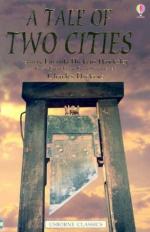|
This section contains 666 words (approx. 3 pages at 300 words per page) |

|
Animal Instinct Vs. Human Compassion Portrayed by Dickens
Summary: The scientific theory of evolution states that humans evolved from apes, therefore we are all, or once were animals. While some religious people choose to ignore this notion, Charles Dickens embraces it in his literary masterpiece, A Tale of Two Cities.
The scientific theory of evolution states that humans evolved from apes, therefore we are all, or once were animals. While some religious people choose to ignore this notion, Charles Dickens embraces it in his literary masterpiece, A Tale of Two Cities. During the French Revolution, inequality was rampant and became the basis of the continuous cycle of oppression. In Charles Dickens' A Tale of Two Cities, animal imagery emphasizes the seemingly never-ending cycle of oppression while establishing that the only way to break the cycle is to possess human compassion.
The cycle of oppression begins when one group dominates another, creating inequality. In the stages preceding the Revolution, the peasants are greatly oppressed by the aristocracy. The lower classes have been told so many times that they are "common dog[s]" (405) that they are starting to believe it is the truth. As a whole, they lack the bravery...
|
This section contains 666 words (approx. 3 pages at 300 words per page) |

|


